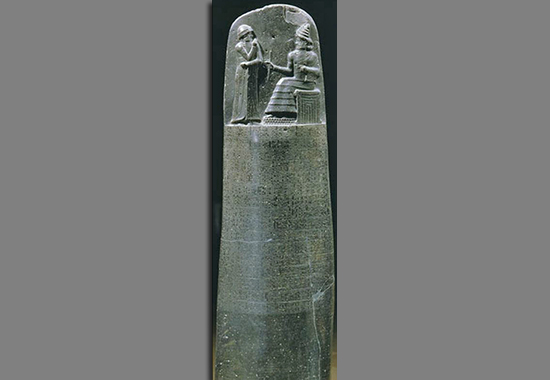|

Babylonian Law: The Code of
Hammurabi, 7 feet 6 inches high
Code of Hammurabi
Hammurabi was the king of Babylon
from around 1792 to 1750 BC. These
are his laws.
Why
care?
Babylonians were dedicated beer
brewers.
|
|
Image Above
Law Code of
Hammurabi, king of Babylon 1792 - 1750 BC
Height:
2.25 meters or 7.38 feet
Width:
0.65 meters or 2.13 feet
Excavations led by
Jacques de Morgan,
1901–1902
© Louvre |
According to the Louvre, the Law Code of Hammurabi is . . .
... the emblem
of the Mesopotamian civilization.
This high
basalt stele erected by the king of Babylon
in the 18th century BC is a work of art,
history and literature, and the most
complete legal compendium of Antiquity,
dating back to earlier than the Biblical
laws.
Carried there
by a prince from the neighboring country of
Elam in Iran in the 12th century BC, the
monument was exhibited on the Susa acropolis
among other prestigious Mesopotamian
masterpieces.
And once more
zoomed in:

Basalt Stele
Containing the Law Code of Hammurabi
©
Louvre
What's
On the Stone Slab?
Who's in the picture?
Utu-Shamash, the god of sun and justice, hands Hammurabi the just
("straight") laws. Refreshingly, Hammurabi is the one standing.
EB further elaborates. We are looking at . . .
... legal
decisions that were collected toward the end
of Hammurabi's reign and inscribed on a
diorite stela and set up in Babylon's temple
of Marduk, the national god of Babylonia.
These 282 case
laws include economic provisions (prices,
tariffs, trade, and commerce), family law
(marriage and divorce), as well as criminal
law (assault, theft) and civil law (slavery,
debt). Penalties varied according to the
status of the offenders and the
circumstances of the offenses.
The existing text is in the Akkadian
(Semitic) language.
Moreover,
despite a few primitive survivals relating
to family solidarity, district
responsibility, trial by ordeal, and the lex
talionis (i.e., an eye for an eye, a tooth
for a tooth), the code was advanced far
beyond tribal custom and recognized no blood
feud, private retribution, or marriage by
capture (bummer)
What's So Special
About the Law Code of Hammurabi?
The Louvre enlightens us:
It is not a
code of laws in the sense that we understand
it today, but rather a compendium of legal
precedents. Contradictions and
illogicalities (two similar cases causing
different results) can be found in the Code,
because it deals with particular judgments,
from which the most personal elements (the
names of the protagonists, for example) have
been removed.
Because
justice was a royal prerogative in
Mesopotamia, Hammurabi here sets out a
selection of the wisest legal decisions that
he had to take or ratify.
Not only does
it contain a list of judicial rulings, but
also a catalogue of the towns and
territories annexed to the kingdom of
Babylon. The stele of the Babylonian king
Hammurabi constitutes a summary of one of
the most prestigious reigns of ancient
Mesopotamia.
Interestingly, Hammurabi's Code stipulated
increased punishment the further down you were
on the social ladder. For the same offense, a
slave had more coming than did a free man, for
example.
So then, is Hammurabi's law code a complete text
of the main Babylonian laws at the time, in the
style of the 10 Mosaic commandments?
No.
Hammurabi's code highlights laws
that needed amendments or otherwise current attention. It
does not cover all issues.
What else does
the Archaeology Desk wants us to remember?
Sets of laws were a common thing
even way back then.
The Babylonian kings didn't mind
micro-managing.
Besides this stele with
Hammurabi's law code, archaeologists dug out many documents
relating to Babylonian business dealings and administration.
Here is more on
 Hammurabi.
Hammurabi.
Here is the
 Chronology of the Rulers
of Babylon.
Chronology of the Rulers
of Babylon.
And speaking of law making, here is more on
 Moses.
Moses.
And here are the
 10 Commandments,
which came down 400 years after Hammurabi's
code.
10 Commandments,
which came down 400 years after Hammurabi's
code.
More History
|